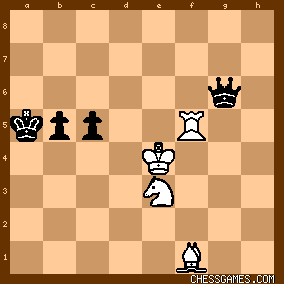| AylerKupp: A Zaitsev vs Tal, 1962 (part 2 of 2) <ughaibu> speculated that if there were no a-pawns Tal would have played on from this position:

click for larger viewThat's possible, since in that case it would seem that Black had all the winning chances. So this is what the same 3 engines came up with: <Critter 1.6a>: [-0.69], d=26: 51.Rc4 Qa1 52.Kg2 Qb2+ 53.Kh3 Kd7 54.Ne4 Kd8 55.Kg4 Qg7+ 56.Kf3 Qf7+ 57.Kg2 Qg6+ 58.Kf2 Qf5+ 59.Kg1 Qf4 60.Ra4 Qf3 61.Ra8+ Kc7 62.Re8 Qg4+ 63.Bg2 Qd7 64.Ra8 Qd4+ 65.Kf1 c4 66.Ra7+ Kc6 67.Nc3+ Kc5 68.Ne2 Qb2

click for larger viewBlack's initial king moves seem very passive but it was able to advance its king later on. Black also managed to advance it's c-pawn one square and seems to be able to advance its b-pawn as well; e.g. 69.Rc7+ Kb4 followed by 70...Kb4.

click for larger viewIn fact, starting from this position Critter evaluates the resulting position at [-1.41], d=24 as Black is able to advance its pawns further and may have realistic winning chances. <Houdini 1.5a>: [-0.52], d=26: 51.Rc4 Qa1 52.Kg2 Qb2+ 53.Kf3 b5 54.Re4+ Kd5 55.Nf5 Kc6 56.Re6+ Kd7 57.Re4 Kc7 58.Ne3 Qb3 59.Re5 Kb6 60.Rf5 Qc3 61.Rf8 Qe5 62.Rf5 Qd4 63.Nd5+ Ka5 64.Ne3 Qd6 65.Rd5 Qc6 66.Ke4 Qg6+ 67.Rf5

click for larger viewBlack has managed to advance its b-pawn and transfer its king to the q-side but not much else. Still, Black may have some winning chances. Starting from this position Houdini evaluates the resulting position at [-0.77], d=24. Better, but no clear winning chances for Black. <Rybka 4.1>: [-0.40], d=26: 51.Rc4 Qa1 52.Kg2 Qb2+ 53.Kf3 b5 54.Re4+ Kd7 55.Nf5 Qb3+ 56.Kf4 Kc6 57.Be2 Qa2 58.Ne7+ Kb6 59.Nc8+ Kc7 60.Na7 Qf7+ 61.Ke3 b4 62.Nb5+ Kd7 63.Bc4 Qg6 64.Re5 Qb1 65.Rd5+ Ke7 66.Kd2

click for larger viewRybka either made a mess of this ending as Black or played inspired defense as White. It managed to advance Black's pawns somewhat but they are thoroughly blockaded and don't seem able to advance any further. In fact, starting from this position Rybka evaluates the resulting position at [-0.00], d=26 evaluating that Black has nothing better than a draw by repetition after 66...Qb2+ 67.Kd3 Qb1+ 68.Kd2 since otherwise Black loses both pawns. So without the a-pawns Black's winning chances improve, but not all that much, so I wouldn't criticize Tal if he had also agreed to a draw if there were no a-pawns in the position. But that's chess engine talk. I don't know which round this game was played but Tal finished in a tie for second place with Taimanov, ½ point behind Korchnoi. So, if this game (without a-pawns) had been played in the latter rounds when Tal needed a win to catch Korchnoi, then I'm certain that Tal would have gone for the win since he was in no danger of losing. | 




